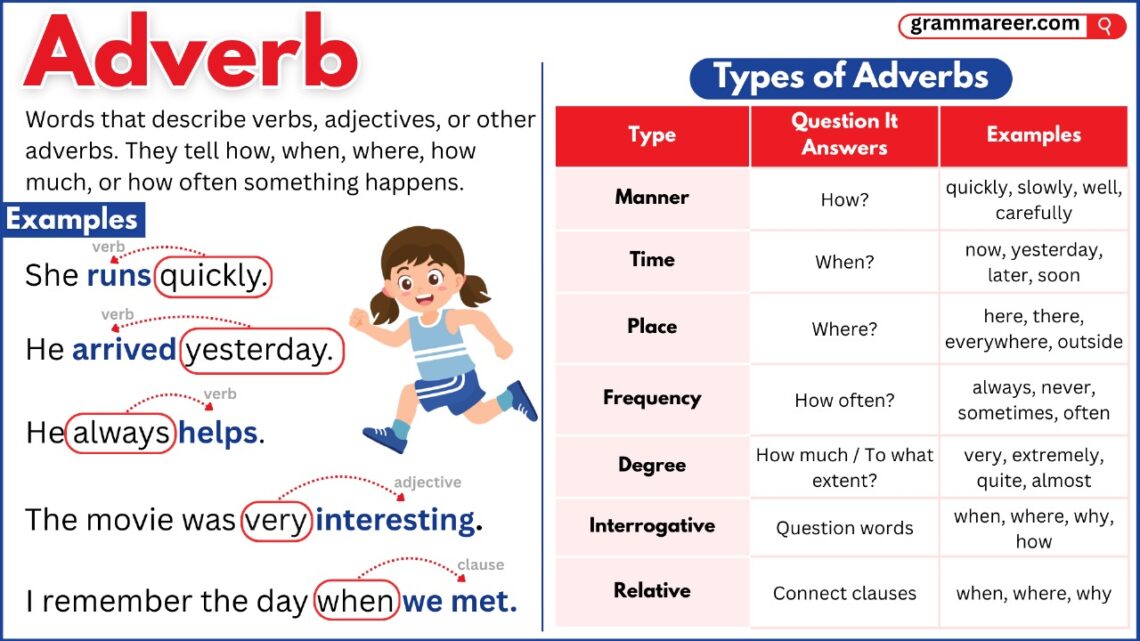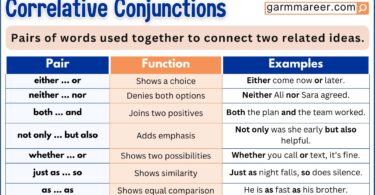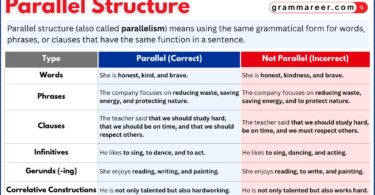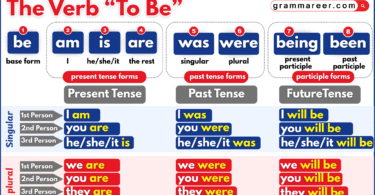Adverbs are simply words we use to add more detail to our sentences. They can explain things like how an action happens, when it takes place, where it occurs, or even how much of it is done.
In this article, we’ll undersatnd what adverbs are, the different types you’ll come across, some easy rules to remember, and clear examples to help you understand them better.
Table of Contents
What are Adverbs?
Adverbs are words that add extra detail to a sentence. They usually tell us how, when, where, or to what extent something happens. You can think of adverbs as helpful words that make the meaning of a verb, adjective, or even another adverb more clear.
For example:
- She runs fast. (how she runs)
- We’ll meet tomorrow. (when we’ll meet)
- The bag is right here. (where the bag is)
- He is very tall. (to what extent)
Many adverbs end in -ly like quickly or happily, but not all of them follow this pattern—words like soon or fast are also adverbs. By using adverbs, your sentences become more precise and expressive.
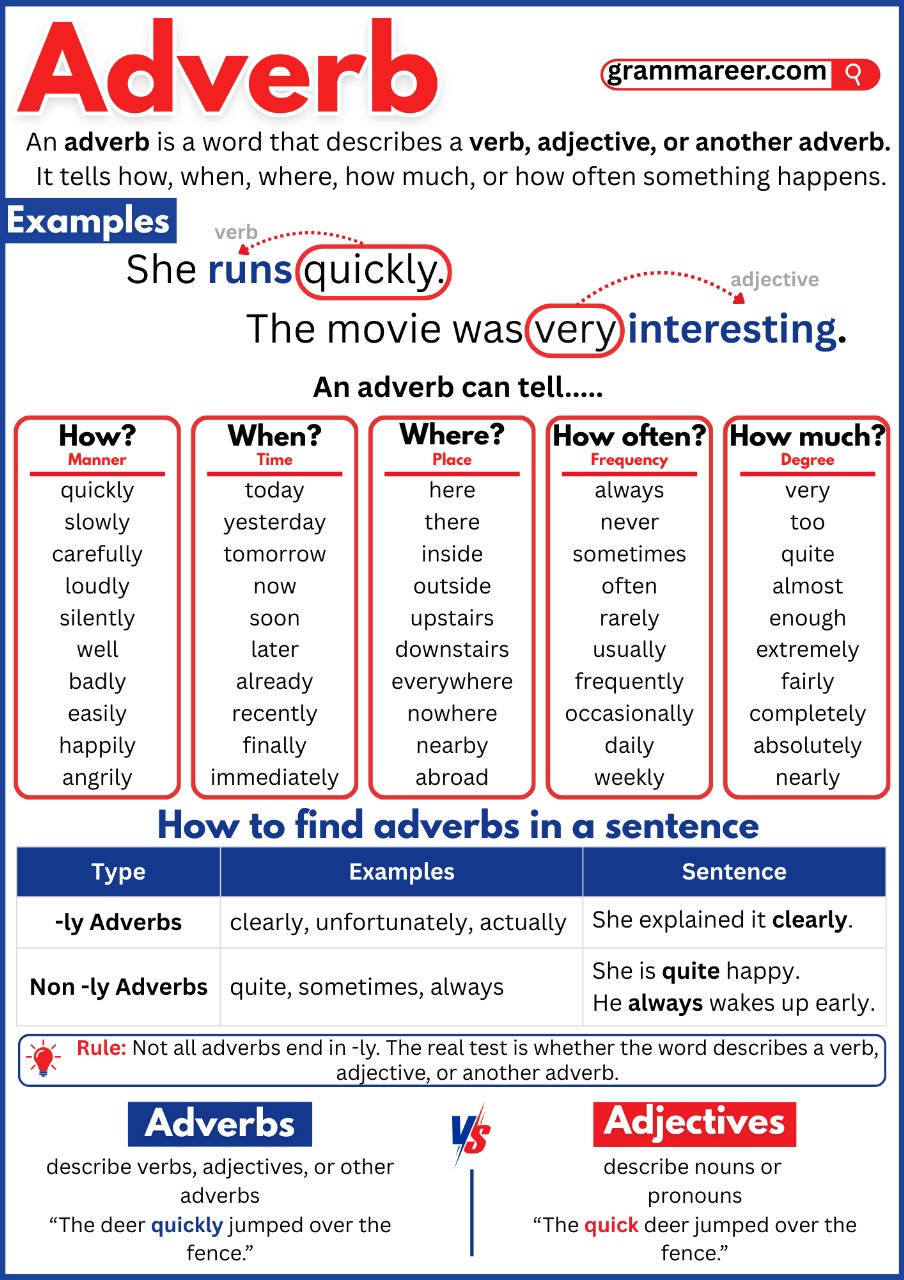
How adverbs modify parts of speech?
Adverbs aren’t limited to verbs — they can change the meaning of other parts of a sentence too. Let’s see how:
- With verbs: They tell us more about the action, like how, when, or where it happens.
Example: He spoke softly. - With adjectives: They make the description stronger or weaker.
Example: The movie was really good. - With other adverbs: They adjust the strength of another adverb.
Example: She finished the race quite quickly. - With whole sentences: They can show the speaker’s attitude or set the tone.
Example: Luckily, the rain stopped before the game.
How Adverbs Are Used in Sentences?
Adverbs are words we use to give more detail to our sentences. For example, if I say Ali runs, you know the action, but not much else. If I say Ali runs quickly, the adverb quickly tells us how he runs.
Adverbs can also change the meaning of adjectives. Imagine someone says, The tea is hot. If I add an adverb and say, The tea is very hot, now you understand it’s not just hot—it’s hotter than usual.
Sometimes an adverb can even change another adverb. For example, She answered quickly is fine, but if I say She answered really quickly, the adverb really makes the meaning stronger.
And sometimes an adverb talks about the whole sentence. Let’s say it was raining but you still got home before the storm. You might say, Fortunately, I reached home on time. The adverb fortunately shows how you feel about the whole situation.
List of Adverbs
| How | When | Where | How much | How often |
| badly | afterward | above | almost | always |
| carefully | early | away | completely | daily |
| cheerfully | already | abroad | barely | annually |
| easily | eventually | back | deeply | frequently |
| gently | later | below | entirely | hardly |
| well | tonight | nearby | too | yearly |
| thoroughly | yet | out | very | usually |
| skillfully | yesterday | inside | totally | seldom |
| peacefully | tomorrow | there | slightly | rarely |
Types of Adverbs
Adverbs aren’t all the same. They can be grouped into different types depending on what they do in a sentence. Let’s look at the main ones with some easy examples.
| Type | What it tells us | Examples |
| Adverbs of time | Show when something happens or for how long | now, later, today, yesterday |
| Adverbs of frequency | Tell us how often something happens | always, often, sometimes, never |
| Adverbs of duration | Explain how long an action lasts | briefly, forever, temporarily |
| Adverbs of manner | Show how an action is done | quickly, slowly, carefully, happily |
| Adverbs of place | Tell us where something happens | here, there, outside, everywhere |
| Adverbs of degree | Show the strength or intensity of something | very, too, almost, completely |
| Adverbs of purpose | Explain why something happens | so, therefore, because, hence |
| Conjunctive adverbs | Join two ideas or sentences together | however, moreover, instead, meanwhile |
Adverbial Phrases and Clauses
So far, we’ve looked at adverbs as single words like quickly, soon, or always. But adverbs don’t always come alone — sometimes they appear as a phrase (a few words working together) or a clause (a group of words with a subject and a verb). These are called adverbial phrases and adverbial clauses. Let’s look at some examples in everyday language.
| Adverbial Phrases of Manner | These tell us how something happens. They often start with words like in, with, like, or as. | • She spoke in a soft voice. • He runs like a professional athlete. |
| Adverbial Phrases of Time | These explain when something happens. They often begin with words like after, before, until, or when. | • I’ll call you after the meeting is over. • She waited until the shop opened. |
| Adverbial Phrases of Place | These show where something happens. They might start with where, wherever, or similar words. | • The kids are playing in the park. • Happiness follows them wherever they go. |
| Adverbial Phrases of Degree | These compare actions or show the level of something. | • He is smarter than he looks. • She worked as hard as she could. |
| Adverbial Clauses of Condition | These show that something happens only if a certain condition is true. | • I’ll help you if you need me. • You won’t succeed unless you try. |
| Adverbial Clauses of Reason | These give us the reason behind something. | • We stayed indoors because it was too hot. • Since you’re here early, let’s start the work now. |
| Adverbial Clauses of Concession | These introduce a contrast with the main idea. | • Although it was raining, we still went for a walk. • She kept smiling, even though she was tired. |
Adverbs and Degrees of Comparison
Just like adjectives, many adverbs can also be compared. This means we can use them to show how an action happens in different ways or at different levels. These forms are called degrees of comparison—positive, comparative, and superlative.
Positive Degree
The positive degree is the basic form of the adverb. It simply tells us how something is done without comparing it to anything else.
Examples:
- She sang beautifully.
- He finished the test quickly.
Comparative Degree
The comparative degree is used when we compare two actions or people. With adverbs that end in -ly, we usually add more before the adverb.
Examples:
- She sang more beautifully than her sister.
- He finished the test more quickly than I did.
Superlative Degree
The superlative degree is used when we compare three or more actions or people. In this case, we add most before the adverb.
Examples:
- She sang most beautifully of all the contestants.
- He finished the test most quickly in the entire class.
Common Mistakes with Adverbs
Adverbs are handy, but many learners make small mistakes when using them. Let’s look at a few common ones.
1. Using adjectives instead of adverbs
This happens a lot. Remember, adjectives describe nouns, while adverbs describe actions.
Example:
- ❌ She sings beautiful.
✅ She sings beautifully.
2. Placing adverbs in the wrong spot
If you put the adverb too far from the word it describes, the meaning can get confusing.
Example:
- ❌ She almost drove her kids to school every day.
✅ She drove her kids to school almost every day.
3. Double negatives with adverbs
Using two negatives makes the sentence incorrect in standard English.
Example:
- ❌ I don’t know nothing about it.
✅ I don’t know anything about it.
4. Overusing intensifiers
Words like very, really, and so are useful, but using them too much can weaken your writing.
Example:
- ❌ The food was very, very good.
✅ The food was delicious.
5. Confusing “good” and “well”
Good is an adjective, and well is usually an adverb (except when it means “healthy”).
Example:
- ❌ She plays the piano good.
✅ She plays the piano well.
You May Also Like

